
Doctors have a new way of thinking about how to treat heart and skeletal muscle diseases.
Body builders have a new way of thinking about how they maximize their power. Both owe their new insight to high-energy X-rays, a moth and cloud computing.
The understanding of how muscles get their power has been greatly expanded with new results published online July 10 in the Royal Society journal Proceedings of the Royal Society B. The Royal Society is the U.K.’s national academy of sciences.
The basics of how a muscle generates power remain the same: Filaments of myosin tugging on filaments of actin shorten, or contract, the muscle – but the power doesn’t just come from what’s happening straight up and down the length of the muscle, as has been assumed for 50 years.
Instead, University of Washington-led research shows that as muscles bulge, the filaments are drawn apart from each other, the myosin tugs at sharper angles over greater distances, and it’s that action that deserves credit for half the change in muscle force scientists have been measuring.
Researchers made this discovery when using computer modeling to test the geometry and physics of the 50-year-old understanding of how muscles work. The computer results of the force trends were validated through X-ray diffraction experiments on moth flight muscle, which is very similar to human cardiac muscle. The X-ray work was led by co-author Thomas Irving, an Illinois Institute of Technology professor and director of the Biophysics Collaborative Access Team (Bio-CAT) beamline at the Advanced Photon Source, which is housed at the U.S. Department of Energy’s Argonne National Laboratory.
A previous lack of readily available access to computational power and X-ray diffraction facilities are two reasons that this is the first time these findings have been documented, speculated lead-author C. David Williams, who earned his doctorate at the UW while conducting the research, and now is a postdoctoral researcher at Harvard University. Currently, X-ray lightsources have a waiting list of about three researchers for every one active experiment. The APS is undergoing an upgrade that will greatly increase access and research power and expedite data collection.
The new understanding of muscle dynamics derived from this study has implications for the research and use of all muscles, including organs.
“In the heart especially, because the muscle surrounds the chambers that fill with blood, being able to account for forces that are generated in several directions during muscle contraction allows for much more accurate and realistic study of how pressure is generated to eject blood from the heart,” said co-author Michael Regnier, a UW bioengineering professor. “The radial and long axis forces that are generated may be differentially compromised in cardiac diseases and these new, detailed models allow this to be studied at a molecular level for the first time. They also take us to a new level in testing therapeutic treatments targeted to contractile proteins for both cardiac and skeletal muscle diseases. ”
This study gives scientists and doctors a new basis for interpreting experiments and understanding the mechanisms that regulate muscle contraction. Researchers have known for sometime that the muscle filament lattice spacing changes over the length-tension curve, but its importance in generating the steep length dependence of force has not been previously demonstrated.
“The predominant thinking of the last 50 years is that 100 percent of the muscle force comes from changes as muscles shorten and myosin and actin filaments overlap. But when we isolated the effects of filament overlap we only got about half the change in force that physiologists know muscles are capable of producing,” Williams said.
The rest of the force, he said, should be credited to the lattice work of filaments as it expands outward in bulging muscle – whether in a body builder’s buff biceps or the calves of a sinewy marathon runner.
“One of the major discoveries that David Williams brought to light is that force is generated in multiple directions, not just along the long axis of muscle as everyone thinks, but also in the radial direction,” said Thomas Daniel, UW professor of biology and co-author on the paper.
“This aspect of muscle force generation has flown under the radar for decades and is now becoming a critical feature of our understanding of normal and pathological aspects of muscle,” Daniel added.
The Latest Bing News on:
Skeletal muscle diseases
- Delpacibart Etedesiran Gets Breakthrough Tx Status for Myotonic Dystrophy Type 1on May 7, 2024 at 5:00 pm
The disease primarily affects skeletal and cardiac muscle and is characterized by muscle weakness, difficulty breathing, cardiac abnormalities, severe gastrointestinal complications, and cognitive and ...
- Therapy Insight: Cardiovascular Complications Associated With Muscular Dystrophyon May 4, 2024 at 5:00 pm
These complications are caused by intrinsic defects in cardiomyocyte and cardiac conduction system function, and by the presence of severe skeletal muscle disease, which also contributes to ...
- Investigational FSHD Drug Did Little to Change DUX4 Expressionon May 2, 2024 at 12:32 pm
The investigational drug losmapimod did not significantly change expression of the gene behind facioscapulohumeral muscular dystrophy (FSHD), but it was associated with potential ...
- A novel deep proteomic approach unveils molecular signatures affected by aging and resistance trainingon April 30, 2024 at 5:00 pm
A new research paper was published in Aging, entitled, “A novel deep proteomic approach in human skeletal muscle unveils distinct molecular signatures affected by aging and resistance training.” ...
- What Happens To Your Body When You Take Creatineon April 29, 2024 at 6:48 am
Creatine is one of the most well-studied supplements used for muscle growth and enhanced athletic performance. What exactly does it do in the body to promote more energy? A registered dietitian ...
- Peripheral Muscle Dysfunction in Patients With COPDon April 24, 2024 at 5:00 pm
The significance of peripheral skeletal muscle disease as a limiting factor in patients with COPD has been emphasized. [1,4,5,6] In fact, some investigators have concluded that muscle dysfunction ...
- International collaboration produces a comprehensive atlas of human skeletal muscle agingon April 21, 2024 at 5:00 pm
In a world with rapidly aging societies, there's a need for a detailed understanding of the cause and progression of diseases associated with aging. Skeletal muscle is the key motor system in the ...
- Diseases that mess with muscleson April 18, 2024 at 5:00 pm
Diseases of the muscles are numerous. Sadly, most of them are distressing, and in some cases life-threatening. Muscles literally hold our bodies together. They also move and support our organs.
- 481 A CTS Team Approach to Investigate Skeletal Muscle Diseases and Countermeasures in a Patient-Derived Bioengineered Muscle Platformon April 2, 2024 at 8:07 pm
Core share and HTML view are not available for this content. However, as you have access to this content, a full PDF is available via the ‘Save PDF’ action button. OBJECTIVES/GOALS: Our team has ...
- mtDNA and Mitochondrial Diseaseson November 24, 2021 at 7:09 pm
skeletal muscle, and cardiac muscle tissues. A number of clinical syndromes are currently believed to be associated with mitochondrial disease. Possible examples include Pearson syndrome ...
The Latest Google Headlines on:
Skeletal muscle diseases
[google_news title=”” keyword=”skeletal muscle diseases” num_posts=”10″ blurb_length=”0″ show_thumb=”left”]
The Latest Bing News on:
Heart muscle diseases
- Cost of two lifesaving heart disease treatments slashedon May 8, 2024 at 8:25 pm
The costs of the two lifesaving heart medicines have been slashed after they were added to the Pharmaceutical Benefits Scheme (PBS).Previously treatment for the two kinds of heart disorder ...
- Heart Failure : What Is It & Treatmentson May 8, 2024 at 1:25 pm
A progressive heart disease that affects pumping action of the heart muscles. This causes fatigue, shortness of breath. This reduces the blood supplied throughout the body, leading to tiredness, ...
- Is exercise safe for people with an inherited heart condition?on May 8, 2024 at 12:33 pm
The updated guidelines, published Wednesday in the American Heart Association journal Circulation, affirm that mild and moderate-intensity recreational exercise is good for people with hypertrophic ...
- 6 Signs of Heart Problems Even Young People Should Knowon May 8, 2024 at 11:06 am
Heart problems you’re born with, a.k.a. congenital heart defects, can impact how effectively yours can pump blood. And it’s possible to develop coronary artery disease (CAD)—the most common type of ...
- Nine in 10 U.S. adults have syndrome that leads to heart diseaseon May 8, 2024 at 10:56 am
Nine of 10 American adults are in the early, middle or late stages of a syndrome that leads to heart disease, a new report finds, and almost 10% have the disease already.
- Your Guide to Exercising for Heart Healthon May 7, 2024 at 1:09 am
Aerobic exercises may target your heart the most, but they’re not the only exercises you should focus on for heart health. A complete exercise program for heart health also includes resistance ...
- Microscopic heart vessels imaged in super-resolution for the first timeon May 6, 2024 at 8:00 am
Researchers from Imperial College London's Department of Bioengineering and Faculty of Medicine worked alongside academics from UCL to produce sub-millimeter resolution images of cardiac micro-vessels ...
- Will Study Linking Vapes With Heart Failure Survive Scrutiny?on May 6, 2024 at 7:46 am
The research has sparked headlines, but has yet to be published in a peer-reviewed journal. Some experts point to red flags.
- Heart Disease Newson May 5, 2024 at 5:00 pm
Cardio-Fitness Cuts Death and Disease by Nearly 20% Apr ... Apr. 26, 2024 — Regenerative heart therapies involve transplanting cardiac muscle cells into damaged areas of the heart to recover ...
- Semaglutide: Weight-loss wonder drug may also prevent heart, kidney diseaseson May 1, 2024 at 5:36 am
Around 70% of American adults are either overweight or clinically obese, according to the Food and Drug Administration (FDA).As CBS12's Dani Travis found out, n ...
The Latest Google Headlines on:
Heart muscle diseases
[google_news title=”” keyword=”heart muscle diseases” num_posts=”10″ blurb_length=”0″ show_thumb=”left”]










